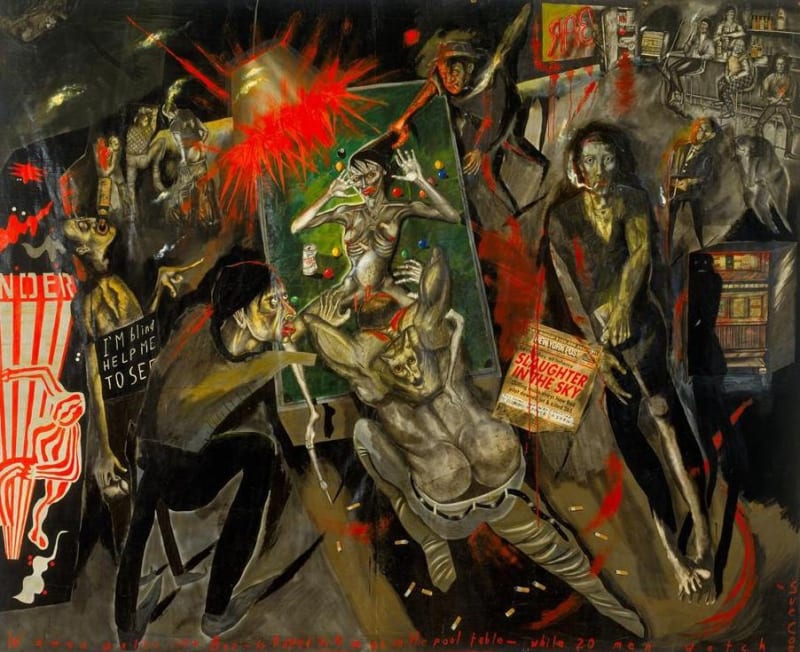After a prolonged courtship involving competing museums, the Museum of Modern Art won the Dannheisser sweepstakes last year, landing 82 works of American and European art from the collection assembled by Elaine Dannheisser and her husband, Werner, during the 1980's and early 90's. Now the museum is sealing the deal with the requisite exhibition, a handsomely installed affair that spreads through half the museum's third floor.
The gift is mostly a good thing. In many instances, it makes up for the missed acquisition opportunities that are a fact of museum life, expanding the Modern's accounting of recent art, especially from the 1980's but reaching as far back as the 1960's while also creeping, somewhat tentatively, into the 90's. It reflects collectors who were often willing to buy in depth and to acquire works that do not dwell quietly above the living room couch or blend with the decor.
Sculpture, video, installation and large-scale photography outnumber paintings here, although there are several works by the painters Brice Marden and Robert Ryman. And generally artists known for abrasive, unsettling or bulky statements prevail. Joseph Beuys, Jeff Koons, Matthew Barney, Sigmar Polke and Cindy Sherman are represented by three to 6 works each; the American sculptors Bruce Nauman and Robert Gober by no less than 10.
High points include Mr. Barney's ''Drawing Restraint No. 7,'' with its ring of suspended video monitors showing tapes of wrestling satyrs in a small, chillingly lighted gallery; two small video works by Mr. Nauman involving double monitors, and the many Gobers, which, installed in their own gallery, amount to a mini-retrospective. The gift also includes a number of impressive firsts for the Modern's collection: sculptures by Reinhard Mucha and Katharina Fritsch, a photo work by Richard Prince and a searing painting of a rape by Sue Coe.
Another standout is a group of works by Felix Gonzalez-Torres, who died in 1996 at the age of 38. His ephemeral and inexpensive idea of beauty, symbolic of the inexorable brevity of life, is everywhere evident here. It is expressed in piles of brightly wrapped candy; stacks of paper printed with a bright blue stripe; a billboard-size photograph of a rumpled bed that suggests absent lovers and a little forest of tall cones made simply of tape and tracing paper. History may not ultimately judge Mr. Gonzalez-Torres as great, but the subversive intent of his art has perhaps never been more evident. In this company he offers a breath of fresh air, continually undercutting the notion of masters and masterworks that lies so undisturbed over most of this exhibition.
Which brings us to why the Danneheisser gift is ''mostly'' a good thing. Perhaps it's poor form to look a gift horse in the mouth, but this collection reflects a consensus-driven taste rather than a highly personal sensibility or rigorous eye. Indeed, recent accounts of the Dannheissers' collecting suggest that they rid themselves of works as soon as they became unfashionable, which may explain the collection's generic tone.
On Sunday a profile of Mrs. Dannheisser in The New York Times's Arts & Leisure section noted that she had sold works by Jennifer Bartlett and others as she became more involved with contemporary art. In the show's catalogue, Kirk Varnedoe, head of the department of painting and sculpture, writes that in the mid-1980's Mrs. Dannheisser sold the works of ''several of the trendiest'' American artists of the moment, including painters like David Salle, so she could concentrate on European artists like Sigmar Polke.
While Mr. Varnedoe may be trying to be forthright about the various incarnations of the Dannheisser holdings, he also makes the jettisoning of work by living artists sound admirable and daring. His essay creates the impression of a collection in continuous flux, which is not unusual, but it is too bad that all the honing and weeding did not result in something that is less by the book and more individual.
The gift seems simply reiterate the Modern's existing profile without much changing its existing outline. The nearly exclusive blue-chipness of the Dannheisser collection exemplifies what art theorists call ''the master narrative,'' that is, art history as the product of a handful of artists working in the supposedly dominant style of the period.
In addition there are low points and dead wood. Once you get beyond the numbers, many of the inclusions seem perfunctory. The works by Ms. Sherman do not always show the artist at her best. Not all the Polkes are first rate, nor is every Nauman. And works by Gilbert and George, Lawrence Weiner, Dan Graham, Anselm Kiefer and Richard Artschwager seem anomalous.
It is a measure of how predictable and fashionable this collection is that a good, early Bartlett or a Salle would seem like eccentric taste in this context. And one longs for works by other far less-known artists working at various angles to the mainstream, just to disrupt the flow of anointed names. This job is largely left to Ms. Coe, whose fiery painting is relegated to a hallway.
But a museum's got to do what a museum's got to do, and a collection like this is valuable not so much for what it looks like as a whole as for how it supplements works that the Modern already owns, some of which reflect a desire to move beyond the mainstream.
All will be revealed as the museum integrates these works into its permanent collection, if not soon, then in the expanded Modern that hovers somewhere in the middle distance. In the meantime, ambitious young collectors who want to see their names on the walls of New York's major museums would do well to study this exhibition carefully, learn from its weaknesses as well as its strengths and try to take art more personally than it has been taken here.
''On the Edge: Contemporary Art From the Werner and Elaine Dannheisser Collection'' will be at the Museum of Modern Art, 11 West 53d Street, through Jan. 20.
